Roles of the Citizens
A citizen is an official member of a community.<br> A citizen has rights and responsibilities. <br>There are some important way to show good citizenship. Read More...
◂Social Studies Worksheets and Study Guides Third Grade. Roles of the Citizens
Study Guide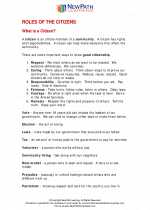 Roles of the Citizens
Roles of the Citizens  Worksheet/Answer key
Worksheet/Answer key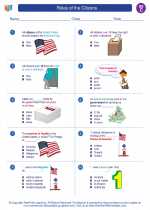 Roles of the Citizens
Roles of the Citizens  Worksheet/Answer key
Worksheet/Answer key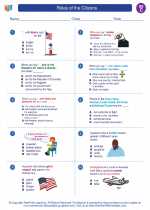 Roles of the Citizens
Roles of the Citizens  Worksheet/Answer key
Worksheet/Answer key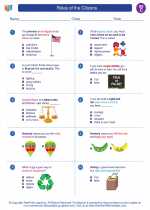 Roles of the Citizens
Roles of the Citizens  Worksheet/Answer key
Worksheet/Answer key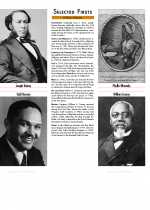 Black History Month
Black History Month 

 Worksheet/Answer key
Worksheet/Answer key
 Worksheet/Answer key
Worksheet/Answer key
 Worksheet/Answer key
Worksheet/Answer key
 Worksheet/Answer key
Worksheet/Answer key

The resources above cover the following skills:
National Curriculum Standards for Social Studies (NCSS)
POWER, AUTHORITY, AND GOVERNANCE
SOCIAL STUDIES PROGRAMS SHOULD INCLUDE EXPERIENCES THAT PROVIDE FOR THE STUDY OF HOW PEOPLE CREATE, INTERACT WITH, AND CHANGE STRUCTURES OF POWER, AUTHORITY, AND GOVERNANCE.
PROCESSES - Learners will be able to:
Examine issues involving the rights and responsibilities of individuals and groups in relation to the broader society.
CIVIC IDEALS AND PRACTICES
SOCIAL STUDIES PROGRAMS SHOULD INCLUDE EXPERIENCES THAT PROVIDE FOR THE STUDY OF THE IDEALS, PRINCIPLES, AND PRACTICES OF CITIZENSHIP IN A DEMOCRATIC REPUBLIC.
KNOWLEDGE - Learners will understand:
The theme of civic ideals and practices helps us know how we can have influence on how people live and act together.
Concepts and ideals such as: individual dignity, fairness, freedom, the common good, rule of law, civic life, rights, and responsibilities.
Key practices in a democratic society include civic participation based on studying community issues, planning, decision-making, voting, and cooperating to promote civic ideals.
Democratic ideals and practices are often represented in excerpts from contemporary and historical sources, quotations, and stories.
The importance of gathering information as the basis for informed civic action.
PROCESSES - Learners will be able to:
Ask and find answers to questions about how to plan for action with others to improve life in the school, community, and beyond.
Identify and exercise the rights and responsibilities of citizens.
Analyze how specific policies or citizen behaviors reflect ideals and practices consistent or inconsistent with democratic ideals.
Examine the influence of citizens and officials on policy decisions.
PRODUCTS - Learners demonstrate understanding by:
Drawing illustrations of examples of participation supportive of civic ideals and practices.
National Standards for Civics and Government (NSCG)
What is Government and What Should It Do? What are some of the most important things governments do?
Functions of government: Students should be able to explain some of the major things governments do in their school, community, state, and nation. To achieve this standard, students should be able to
Explain how government makes it possible for people working together to accomplish goals they could not achieve alone
What is Government and What Should It Do? Why is it important to limit the power of government?
Importance of limited government: Students should be able to explain why limiting the power of government is important to their own lives. To achieve this standard, students should be able to
Explain why limited government is important for the protection of individual rights such as
Political rights to vote
What are the Basic Values and Principles of American Democracy? What are the most important values and principles of American democracy?
Fundamental values and principles: Students should be able to explain the importance of the fundamental values and principles of American democracy. To achieve this standard, students should be able to
Explain the importance for themselves, their school, their community, and their nation of each of the following fundamental values of American democracy:
Patriotism
Explain the importance for themselves, their school, their community, and their nation of each of the following fundamental principles of American democracy:
People exercise their authority directly by voting for or against certain rules, laws, or candidates as well as by voting in community or town meetings
Identify fundamental values and principles as they are expressed in the Declaration of Independence, Preamble to the United States Constitution, the Bill of Rights, Pledge of Allegiance, speeches, songs, and stories
What are the Basic Values and Principles of American Democracy? What are some important beliefs Americans have about themselves and their government?
Distinctive characteristics of American society: Students should be able to identify some important beliefs commonly held by Americans about themselves and their government. To achieve this standard, students should be able to describe the following beliefs commonly held by Americans:
Importance of the individual: Students should be able to explain that Americans believe
The vote of one individual should count as much as another’s
Importance of their school, community, state, and nation: Students should be able to explain that Americans believe that
Everyone should be concerned about the well-being of his/her school, community, state, and nation
People should try to improve the quality of life in their schools, communities, states, and nation
Importance of equality of opportunity and equal protection of the law: Students should be able to explain that Americans believe that
All people have a right to participate in political life by expressing their opinions and trying to persuade others; all citizens over 18 years of age have the right to vote; and citizens who meet age and other qualifications have the right to seek public office
What are the Basic Values and Principles of American Democracy? Why is it important for Americans to share certain values, principles, and beliefs?
American identity: Students should be able to explain the importance of Americans sharing and supporting certain values, principles, and beliefs. To achieve this standard, students should be able to
Identify basic documents that set forth shared values, principles, and beliefs, e.g., Declaration of Independence, United States Constitution and Bill of Rights, Pledge of Allegiance
What are the Basic Values and Principles of American Democracy? How can people work together to promote the values and principles of American democracy?
Promoting ideals: Students should be able to identify ways people can work together to promote the values and principles of American democracy. To achieve this standard, students should be able to
Explain how they can promote the values and principles of American democracy by
Participating in government, e.g., voting, becoming informed about public issues, attempting to change laws by writing to legislators, serving on juries
How Does the Government Established by the Constitution Embody the Purposes, Values, and Principles of American Democracy? What does the national government do and how does it protect individual rights and promote the common good?
Organization and major responsibilities of the national government: Students should be able to give examples of ways the national government protects individual rights and promotes the common good. To achieve this standard, students should be able to explain that
The judicial branch, headed by the Supreme Court, makes decisions concerning the law that are intended to
Protect individual rights, e.g., the right to a fair trial, to vote, to practice one’s religious beliefs
How Does the Government Established by the Constitution Embody the Purposes, Values, and Principles of American Democracy? What are the major responsibilities of state governments?
Organization and major responsibilities of state governments: Students should be able to explain the most important responsibilities of their state government. To achieve this standard, students should be able to
Explain how people can participate in their state government, e.g., being informed and taking part in discussions of state issues, voting, volunteering their services, holding public office, serving on governing committees and commissions
Explain why it is important that people participate in their state government, e.g., to protect their rights and promote the common welfare, improve the quality of life in their community, to gain personal satisfaction, to prevent officials from abusing their power
How Does the Government Established by the Constitution Embody the Purposes, Values, and Principles of American Democracy? What are the major responsibilities of local governments?
Organization and major responsibilities of local governments: Students should be able to explain the most important responsibilities of their local government. To achieve this standard, students should be able to
Explain how people can participate in their local government, e.g., being informed and taking part in discussions of local issues, voting, volunteering their services, holding public office, serving on governing committees and commissions
Explain why it is important that people participate in their local government, e.g., to protect their rights and promote the common good, improve the quality of life in their community, to gain personal satisfaction, to prevent officials from abusing their power
What are the Roles of the Citizen in American Democracy? What does it mean to be a citizen of the United States?
The meaning of citizenship: Students should be able to explain the meaning of citizenship in the United States. To achieve this standard, students should be able to
Explain the important characteristics of citizenship in the United States. Specifically, citizenship
Means that a person is recognized as a legal member of the nation
Means each person has certain responsibilities, e.g., respecting the law, voting, paying taxes, serving on juries
What are the Roles of the Citizen in American Democracy? How does a person become a citizen?
Becoming a citizen: Students should be able to explain how one becomes a citizen of the United States. To achieve this standard, students should be able to
Explain the difference between a citizen and a non-citizen (alien)
Explain that people become citizens by birth or naturalization
What are the Roles of the Citizen in American Democracy? What are important responsibilities of Americans?
Responsibilities of individuals: Students should be able to explain why certain responsibilities are important to themselves and their family, community, state, and nation. To achieve this standard, students should be able to identify such responsibilities as the following and explain their importance:
Civic responsibilities, e.g., obeying the law, respecting the rights of others, being informed and attentive to the needs of their community, paying attention to how well their elected leaders are doing their jobs, communicating with their representatives in their school, local, state, and national governments, voting, paying taxes, serving on juries, serving in the armed forces
What are the Roles of the Citizen in American Democracy? What dispositions or traits of character are important to the preservation and improvement of American democracy?
Dispositions that enhance citizen effectiveness and promote the healthy functioning of American democracy: Students should be able to explain the importance of certain dispositions to themselves and American democracy. To achieve this standard, students should be able to
Explain the importance of the following dispositions
Individual responsibility—fulfilling one’s responsibilities to family, friends, and others in one’s community and nation
Civic mindedness—concern for the wellbeing of one’s community and nation
Patriotism—loyalty to the values and principles underlying American constitutional democracy
What are the Roles of the Citizen in American Democracy? How can Americans participate in their government?
Forms of participation: Students should be able to describe the means by which citizens can influence the decisions and actions of their government. To achieve this standard, students should be able to
Identify ways people can monitor and influence the decisions and actions of their government
Voting
Taking an active role in interest groups, political parties, and other organizations that attempt to influence public policy and elections
Explain why it is important for citizens to monitor their local, state and national governments
What are the Roles of the Citizen in American Democracy? What is the importance of political leadership and public service?
Political leadership and public service: Students should be able to explain the importance of political leadership and public service in their school, community, state, and nation. To achieve this standard, students should be able to
Explain why leadership and public service are important to the continuance and improvement of American democracy
National Center for History in Schools (NCHS)
Topic 3: The History of the United States: Democratic Principles and Values and the People from Many Cultures Who Contributed to Its Cultural, Economic, and Political Heritage
How democratic values came to be, and how they have been exemplified by people, events, and symbols.
Demonstrate understanding of ordinary people who have exemplified values and principles of American democracy.
The causes and nature of various movements of large groups of people into and within the United States, now, and long ago.
Demonstrate understanding of the movements of large groups of people into his or her own and other states in the United States now and long ago.